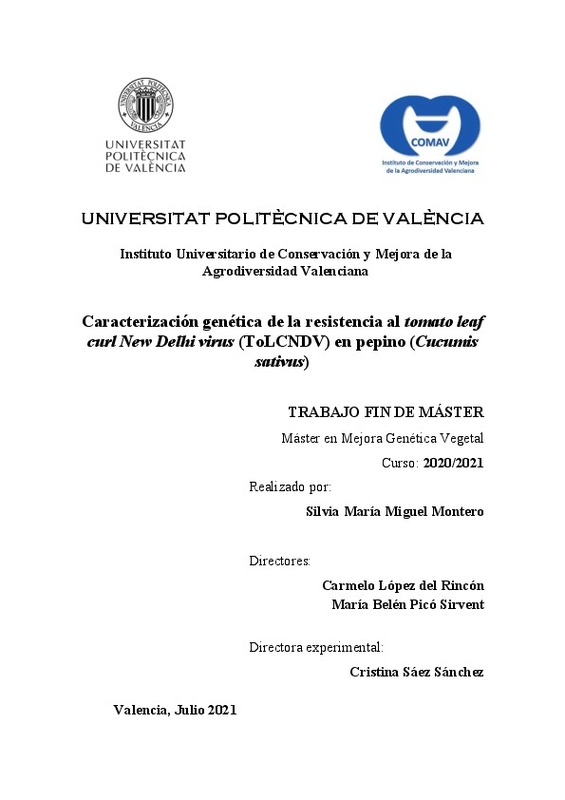|
Resumen:
|
[ES] La familia de las cucurbitáceas (Cucurbitaceae) está constituida por una gran diversidad de géneros y especies, entre los que se encuentran cultivos de elevado valor agronómico como el pepino (Cucumis sativus). Entre ...[+]
[ES] La familia de las cucurbitáceas (Cucurbitaceae) está constituida por una gran diversidad de géneros y especies, entre los que se encuentran cultivos de elevado valor agronómico como el pepino (Cucumis sativus). Entre los principales factores que amenazan su cultivo y producción a nivel mundial destacan las enfermedades causadas por virus. En España, el virus de la hoja rizada del tomate de Nueva Delhi (Tomato leaf curl New Delhi virus, ToLCNDV) se detectó por primera vez en el sudeste peninsular durante la campaña 2012-2013 infectando sobre todo cultivos de calabacín. Sin embargo, en los últimos años se ha descrito un incremento de la incidencia de esta virosis en explotaciones intensivas de pepino, mermando las cosechas y su rentabilidad económica. La estrategia de control más efectiva para combatir las enfermedades víricas es el empleo de variedades que incorporen genes de resistencia. En trabajos previos, los grupos de virología y mejora genética de cucurbitáceas del COMAV-UPV llevaron a cabo un cribado de colecciones de germoplasma de C. sativus que incluían accesiones de diversos orígenes geográficos. Estas evaluaciones permitieron identificar tres fuentes de resistencia al virus en pepino, todas ellas procedentes de la India. El objetivo de este Trabajo Final de Máster es el estudio del tipo de herencia que controla la resistencia al ToLCNDV en una de las accesiones de pepino resistentes al virus. Para ello, se ha realizado el cruce entre plantas del genotipo resistente con un genotipo susceptible. Los híbridos F1 obtenidos se han autofecundado y retrocruzado para generar las poblaciones segregantes F2 y BC. Todas las plantas de las diferentes familias obtenidas han sido inoculadas mecánicamente con un clon infeccioso del virus y fenotipadas según su nivel de sintomatología y carga viral por tissue printing. La proporción de plantas resistentes:susceptibles observadas en cada población segregante es compatible con un modelo de herencia monogénico recesivo. Para identificar la región o regiones del genoma de pepino involucradas en la resistencia, se ha realizado un genotipado mediante marcadores de tipo SNP repartidos por los siete cromosomas de C. sativus. El análisis mediante softwares de cartografía de genes ha permitido identificar un QTL ligado al desarrollo de síntomas y acumulación viral del ToLCNDV en el cromosoma 2 de pepino. No obstante, son necesarios análisis adicionales que permitan acotar este locus e identificar los genes candidatos y marcadores moleculares que asistan la transferencia de la resistencia a cultivares de élite comerciales.
[-]
[EN] The cucurbit family (Cucurbitaceae) is constituted by diverse genera and species, among which are crops of high agronomic value such as cucumber (Cucumis sativus). Among the main factors that threaten its cultivation ...[+]
[EN] The cucurbit family (Cucurbitaceae) is constituted by diverse genera and species, among which are crops of high agronomic value such as cucumber (Cucumis sativus). Among the main factors that threaten its cultivation and production worldwide are diseases caused by viruses. In Spain, Tomato leaf curl New Delhi virus (ToLCNDV) was detected for the first time in southern peninsular during the 2012-2013 season, infecting mainly zucchini crops. However, an increasement in the incidence of this virus has been described recently in intensive cucumber farms, reducing harvests and their economic profitability. The most effective control strategy to control viral diseases is the use of varieties with resistance genes. In previous works, both Virology and Cucurbit Breeding groups at COMAV-UPV institute carried out a screening of C. sativus germplasm collections that included accessions from diverse geographical origins. These evaluations made possible to identify three sources of resistance to the virus in cucumber, all of them original from India. The objective of this Final Master's Thesis is the study of the inheritance that controls resistance to ToLCNDV in one of the virus-resistant cucumber accessions. For this purpose, crosses between resistant and susceptible cucumber plants were carried out. The resulting F1 hybrids have been selfed and backcrossed to generate the segregating populations F2 and BCs. All the plants belonging to the different families have been mechanically inoculated with an infectious clone of the virus and phenotyped according to symptom development and viral load by tissue printing. The ratio of resistant:susceptible plants observed in each segregating population is consistent with a recessive monogenic inheritance pattern. A genotyping assay by single nucleotide polymorphism (SNPs) molecular markers, distributed along the seven chromosomes of C. sativus, was performed to identify the region or regions of the cucumber genome involved in the resistance. After the analysis by gene mapping softwares, a QTL linked to the development of symptoms and viral accumulation of ToLCNDV was identified on cucumber chromosome 2. However, additional analyzes are required to narrow down this locus and identify candidate genes and molecular markers that assist the transference of the resistance to commercial elite cultivars.
[-]
|







